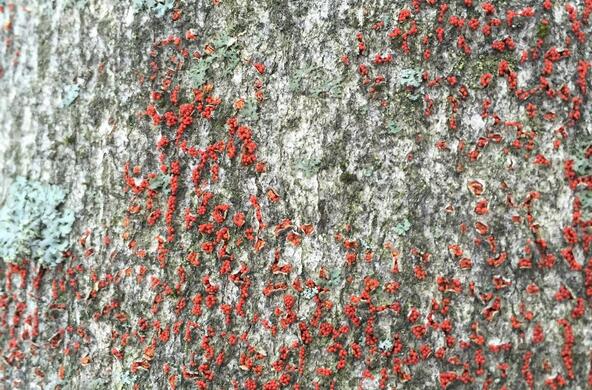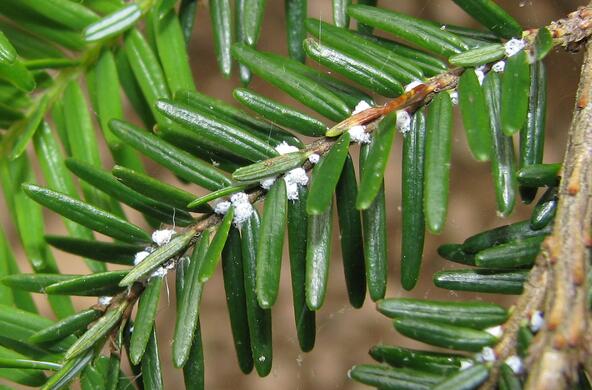If you are a nature lover and you think finding a shiny, metallic-green insect sounds delightful, then you haven’t met the emerald ash borer. Known by its acronym EAB, the emerald ash borer is a small (~1/2”) invasive beetle that is killing ash trees throughout the eastern half of the US. The EAB is in the family known as “jewel beetles” (Buprestidae) with good reason—it is a beautiful insect, and it would be pretty sight if it weren’t so harmful. Unfortunately, EAB is the most destructive and costly forest insect to ever have invaded North America.
What is the emerald ash borer and why is it a problem?
The EAB (Agrilus planipennis), which attacks all 16 species of ash trees in North America, has killed hundreds of millions of ash trees so far. The adult beetles consume foliage but do not cause much defoliation. The real problem is caused by the larvae, which tunnel through the wood just under the bark and damage the tree’s ability to transport nutrients and water. Heavily infested trees usually die within 2-4 years. The adult beetles emerge from the tree in May through June; they live for a few weeks, mate and deposit eggs in bark crevices. The eggs hatch into the larvae, which feed from mid-summer into fall and then overwinter before pupating in the spring.
In its native range in Asia, the EAB primarily attacks and kills unhealthy, stressed trees. However, in North America, it can also kill healthy ash trees. While the insect has been found to have slight preferences for one ash species over another, eventually all ash species are attacked. EAB is not known to attack any trees other than ash. In areas where EAB infestation is severe, over 99% of the ash trees may die1. As a result, many experts expect the functional extirpation of the ash genus (Fraxinus) in North America as the EAB spreads throughout the continent1.
Where did the emerald ash borer come from and how did it get here?
The EAB is native to China, Korea, and eastern Russia. It likely was transported to North America in wooden crating, pallets, or dunnage used in international shipping. It was first discovered in the US near Detroit, Michigan in 2002, and soon thereafter populations were also found near Windsor in southern Ontario. Subsequent investigations indicated that the EAB population in the Detroit area had been growing undetected since the early to mid 1990s2.
In a very unfortunate failure of communication, the vulnerability of North American ash trees to EAB was known to Chinese scientists and forest managers, and was published as early as 1966 in a Chinese horticultural paper1. This information never reached authorities in the US and Canada, who were caught unaware by the EAB infestation discovered in 2002.
Adult EAB are relatively strong fliers and some have been reported to colonize trees more than 800m from their emergence point1. However, the long-distance movement of EAB is greatly facilitated by people, particularly by people moving infested firewood. Often satellite outbreaks of EAB are found near campgrounds, presumably because a camper has brought in ash firewood from an infested tree. Despite “Don’t move firewood” education campaigns, firewood regulations, and state and federal quarantines, the spread of the EAB across the US since 2002 has been relentless. As of early 2022, it is present in 35 US states and five Canadian provinces. Its westward expansion has so far reached Colorado. It has not yet arrived on the West Coast where there are two vulnerable ash species, Oregon ash and velvet ash. However, because of the long-distance dispersal by humans, it is likely to do so eventually.

What are the ecological and economic impacts of the emerald ash borer?
All of North America’s > 8 billion ash trees are at risk from EAB3. White ash is an important component of hardwood forests throughout the East, and green ash and black ash are very important wetland and riparian trees. In many areas ash trees dominate forested wetlands, and outbreaks of EAB can completely remove the forest cover.
Ash wood has many specialized uses, including as the principal wood used in baseball bats. Native American tribes use ash, especially black ash, to make baskets because the wood splits easily into thin strips along the growth rings. Black ash is an important part of the history, culture and tradition of numerous eastern and Midwestern tribes.

Because ash is widely planted as a street tree, the greatest economic impacts of EAB have been, and will be, felt in cities. One earlier estimate put the cost of ash tree treatment and removal in US cities at $12.5 billion through 20204. A recent study estimates EAB may potentially kill ~1.3 million more street trees through 2050, costing municipalities and homeowners approximately $26 million per year5. In addition to the economic cost, the loss of these urban trees eliminates the other environmental values they provide, including shading streets and buildings, cooling the air, absorbing stormwater runoff, and removing air pollution. The quality of life in cities is also affected--loss of ash trees in Midwestern cities has been associated with increasing hospitalization and death from cardiovascular and respiratory ailments6, and with increased crime7.
What are the symptoms of emerald ash borer infestation?
Most people are unlikely to see the EAB insect itself because the adults are small and short-lived, and the larvae are hidden in the trunk of the tree. One of the telltale symptoms of EAB infestation is areas where woodpeckers remove the outer bark and expose the tan-colored inner bark in their search for a meal. This “bronzing” is often seen first near the top of the tree. Another key indicator is the D-shaped exit holes, 2-3 mm (~0.1 inch) across, that are made by the emerging adults.

What can be done to stop emerald ash borer infestation?
The EAB has spread so widely that it will never be eradicated from North America, and it is highly likely that most North American ash trees will die from this invasive pest. Individual trees can be treated to kill EAB if the infestation is caught early enough. The most common treatment is with systemic application of the insecticide emamectin benzoate, which needs to be re-applied every few years to keep the insect at bay. Because of their expense and potential toxicity to non-target organisms, insecticides are used for treatment of individual landscape trees rather than for broad-scale application. Infested trees in cities and near structures are usually removed because they pose a danger to people and property.
Broader-scale responses to the EAB infestation focus on breeding resistant ash trees and developing biological control agents. A small percentage of ash trees may survive when he EAB infests an area, and these resistant ash can provide the genetic material for breeding programs to develop EAB-tolerant ash trees8. Asian ash trees, which are resistant to EAB, may also provide genetic material.
Biological control refers to using predators, parasites, or diseases to attack an unwanted pest. The aim is not to eradicate the pest but to keep the populations at levels that cause less harm. The USDA is leading an effort to develop biological control agents for EAB, and the most promising candidate so far is a parasitic wasp (Spathius galinae) that lays its eggs in the EAB larvae. The larvae of the wasp eventually kill the EAB larvae. This wasp has been released at many sites in the area of EAB invasion, and it is showing some glimmers of success in reducing EAB populations and spreading to new areas9. While this is cause for optimism, it should be tempered with the knowledge that attempts at biological control of invasive insects are often unsuccessful. Nonetheless, over the long term, biological control and resistance breeding provide the best hope for the eventual restoration of ash trees in North America.
Footnotes
1Herms, D. A. and D. G. McCullough. 2014. Emerald Ash Borer invasion of North America: History, biology, ecology, impacts, and management. Annual Review of Entomology, Vol 59, 2014 59:13-30.
1Siegert, N. W., D. G. McCullough, A. M. Liebhold, and F. W. Telewski. 2014. Dendrochronological reconstruction of the epicentre and early spread of emerald ash borer in North America. Diversity and Distributions 20:847-858.
3Flower, C. E., K. S. Knight, and M. A. Gonzalez-Meler. 2013. Impacts of the emerald ash borer (Agrilus planipennis Fairmaire) induced ash (Fraxinus spp.) mortality on forest carbon cycling and successional dynamics in the eastern United States. Biological Invasions 15:931-944.
4Kovacs, K. F., R. J. Mercader, R. G. Haight, N. W. Siegert, D. G. McCullough, and A. M. Liebhold. 2011. The influence of satellite populations of emerald ash borer on projected economic costs in US communities, 2010-2020. Journal of Environmental Management 92:2170-2181.
5Hudgins, E. J., F. H. Koch, M. J. Ambrose, and B. Leung.2022. Hotspots of pest-induced US urban tree death, 2020-2050. Journal of Applied Ecology. DOI: 10.1111/1365-2664.14141
6Donovan, G. H., D. T. Butry, Y. L. Michael, J. P. Prestemon, A. M. Liebhold, D. Gatziolis, and M. Y. Mao. 2013. The relationship between trees and human health evidence from the spread of the Emerald Ash Borer. American Journal of Preventive Medicine 44:139-145.
7Kondo, M. C., S. Han, G. H. Donovan, and J. M. MacDonald. 2017. The association between urban trees and crime: Evidence from the spread of the emerald ash borer in Cincinnati. Landscape and Urban Planning 157:193-199.
8Steiner, K. C., L. E. Graboski, K. S. Knight, J. L. Koch, and M. E. Mason. 2019. Genetic, spatial, and temporal aspects of decline and mortality in a Fraxinus provenance test following invasion by the emerald ash borer. Biological Invasions 21:3439-3450.
9Duan, J. J., R. G. Van Driesche, J. Schmude, R. Crandall, C. Rutlege, N. Quinn, B. H. Slager, J. R. Gould, and J. S. Elkinton. 2021. Significant suppression of invasive emerald ash borer by introduced parasitoids: potential for North American ash recovery. Journal of Pest Science. DOI: 10.1007/s10340-021-01441-9







